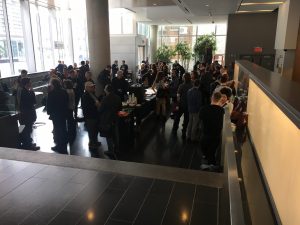
“Less is better” is a dictum that doesn’t just haunt Matt Sheedy. I feel as though that spectral proverb from J.Z. Smith may apply as much to conferences as the classroom. The phrase resonates with my cultural heritage, too. There’s a cookbook title, famous among certain generations of Mennonites, that encapsulates the bent of that culture: “More-with-Less.”
Conferences come in a variety of sizes. Some are attended in the dozens to hundreds whereas others tip past the thousands. Each conference ranges between more and less in a variety of ways, but it seems to me that Smith’s pedagogy and my cultural heritage converge on the direct correlation between attendance and outcomes. The more the people, the less I appreciate the conference.
What follows is not theorizing that supports the claim, but anecdotal evidence accompanied by some ideas for action.
Given the limits of time and resources afforded someone working at a public institution, I regularly attend two academic conferences. I just returned from the 2018 Derrida Today conference, which was organized by Nicole Anderson and was hosted by Matthias Fritsch at Concordia University. The biennial event draws roughly 200 scholars from institutions around the world. The other event is the annual AAR meeting, where thousands of scholars from mostly U.S. institutions converge in the conference centers and hotels of a few U.S. cities.

The energy and inspiration generated for me by Derrida Today is largely attributable to its structure and planning. The goal is to facilitate scholarly relationships through formal and informal interactions. Panels have rules of 20 minute presentations accompanied by 40-60 minute discussion times. On several occasions, the room was reminded that the discussion period had ended. Between each panel session are food and drink in a central area, where discussions are often transformed by the addition of new voices. There six keynotes across three days, reserved for significant scholars in the field, are given to full amphitheaters. Each day is full! Sessions, breaks and keynotes run from 9:30 AM to 7:30 PM. I find each day deeply satisfying.
My first AAR conference was in 2002 at Toronto. Jacques Derrida was both attending and presenting. I’ll be honest: it was my best AAR experience to date. I got to know a group of people who consistently showed up at the same sessions. Following that, my experience of AAR conferences has been described by social theorists as alienation.
Here is my puzzle: I return from the former with a passion to continue my work, whereas I always return from the latter exhausted and ready to do something else.
I know that the difference is entirely attributable to my skills at navigating large events. For example, I prefer small venues for concerts. I prefer to attend shows at Birmingham’s excellent small venues such as Saturn, Iron City and WorkPlay. The last time I went to a large concert was when Stevie Wonder played the Montreal Jazz Festival. That time, me and the other 150,000 people walked home humming and smiling. But just take a look at the faces of the people walking past the UA REL faculty during the Department’s video of the 2012 AAR. Do you see anyone smiling or humming their way past Dr. Trost at 5:53? Perhaps I am not the only one?
But here is what I find truly vexing: I am a gregarious extrovert. I enjoy meeting new people and learning from them. I typically dive into social situations. I want to meet everyone in the room to find out what their research is and how they set about doing their work. For example, here is what I had to say about attending a recent event at UA:
Despite the best efforts of the greatest conference organizing minds, I will experience the AAR annual meetings as a religious studies Leviathan. 
Gigantic events completely overwhelm my extroverted proclivities. As a result, I respond by withdrawing. The social waters are too deep. Perhaps something in my psyche says, “Welcome to the AAR, Nat! Good luck meeting and knowing anyone amid the hundreds of people careening past you in these hallways of AAR meetings!” Whatever that “switch” may be, it doesn’t trip at small conferences.
If large conferences “just don’t work” for me, then I need to figure out some strategies.
I find it difficult to sidestep the effects of instrumental rationality required to make it possible for thousands of scholars to present in the space of a several days. Social and spatial savvy is required to navigate the mazes of hotel conference facilities, whose geography and features are not easily distinguishable. Conference programs, websites, apps and maps are some help. Making sense of their relationships to my academic interests, however, is akin to embarking on the first phase of a digital humanities GIS project; except the compressed time of a conference ensures that the project cannot be finished. It doesn’t really get started. Rather than inspired, I come away feeling alienated from my scholarship.
What to do? With a limited research budget, there is a rational imperative to make the most of these funds.
First: I plan to consistently attend smaller academic events that “work” for my research interests.
Second: I am going to consider forgoing attendance at the AAR and find another small conference that proves more academically useful. Perhaps attending NAASR is some kind of compromise to entirely saying good-bye to the “guild dues” of attending AAR annual meetings?
Third: I want to overhaul my approach to any conference over 200 persons. What might this entail? It could be commitment to a limited series of topics or research groups. Doing so does not resolve the most alienating piece of the large conference social puzzle: nobody else is necessarily doing likewise. Most everyone at these events seems to be bowling alone. Over the long term, my strategy may be to find a wingmate who can collaboratively commit to threading through the large conference. Another is to choose one topic or keyword to follow through the program. What is your strategy?
This is among the reasons I don’t like the annual AAR/SBL conference at the large conference venues–the organizations went on an empire-building phase a couple decades ago, with their come-one-come-all sense of the field and it’s now gotten so large that these are the only places that can contain it now (either that or spreading us across 4 or 5 or 6 different hotels), such that the chance meetings between sessions in hotel hallways and lobbies are now lost since we’re all rushing between rooms in hotels or conference venues that are blocks or miles apart in whatever city happens to be large enough to host us… I have a nice memory of one meeting in Chicago, years ago, when the meeting was in two hotels across the street from one another…, as opposed to the year you had to take buses or cabs across Chicago to get to a conference venue south of the downtown…